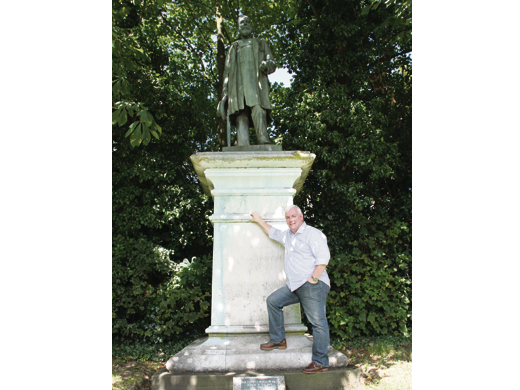Could ‘The Waterlows' be the next Downton Abbey?
Thursday, 15th August 2013

Sir Christopher Waterlow with the statue of his great, great, great-grandfather, Sir Sydney Waterlow
Published: 15 August, 2013
by AMY SMITH
PLANS are being put in place to bring a “Downton Abbey-style” drama series charting five generations of a Highgate printing dynasty to television screens.
The tumultuous lives and loves of the Waterlow family – from which Highgate’s ever popular park takes its name – have been detailed in new book The House of Waterlow: A Printer’s Tale.
The history of the family could be mistaken for a work of fiction – it features murder, high court battles, political intrigue and bitter family feuds marring the noble ambitions of philanthropist Sir Sydney Waterlow.
His great, great, great-grandson, Sir Christopher Waterlow, the 5th Baronet, has put the story into words and the next step could be a television adaptation in the vein of Downton Abbey or Mr Selfridge.
He said: “The Waterlow history is very suited to develop into a feature film or a multi-part drama along the lines of Downton Abbey or Mr Selfridge. We’re developing a treatment and working on timelines. It’s early stages but something we definitely want to do.”
The book has been a labour of love for Chris. He began writing 17 years ago, dipping in and out of family trees and old printing brochures while working as a lighting cameraman for home shopping channel QVC.
His great, great, great-grandfather is perhaps best known for donating his Highgate garden – Waterlow Park – to the public as “a garden for the gardenless” and gifting Lauderdale House to St Bart’s Hospital as a convalescent home for the poor. Sydney worked his way up from printer’s apprentice to Lord Mayor of London and head of one of the biggest printing firms in the country, responsible for printing stamps, passports, stocks and bonds, stationery and money.
Chris recalls being taken to Lauderdale House many times as a boy and has photos of himself, aged four, posing next to the Sydney’s statue in Waterlow Park. But family history did not become important for him until later in life.
“It didn’t really sink in as a boy, only when I was older did I realise the impact he (Sydney) made on so many,” he said. “The more I learn about the family history, the more I come to be very fond of him.”
Chris eagerly recounts tales of his relative’s philanthropic nature: a combination of prudency and generosity. He was a man who would tear off and re-use any blank paper from letters received, but would also sooner donate £500 than £5 to a worthy cause.
His company hit the headlines in 1925 with one of the biggest fraud and forgery cases in British legal history.
The “Portuguese Bank Note Crisis” saw Artur Virgílio Alves Reis dupe William Alfred Waterlow into printing 100 million escudos of Portuguese banknotes. But Waterlow & Sons bounced back when they secured the highly desirable contract to print The Radio Times.
The Waterlows were to once again make front-page news with a shocking murder.
As author Chris has no children, his heir to the “Waterlow of London” baronetcy was Nick Waterlow, an influential art curator who lived in Australia.
But in November 2009 Nick’s son Antony, who had been diagnosed with paranoid schizophrenia, stabbed his father and sister Chloe to death.
He was found not guilty by reason of mental illness and is detained inside a psychiatric hospital. Yet, with his father’s death, Antony now becomes heir to succeed Chris to the title.
A tragic twist to the tale of the 200-year dynasty built by a celebrated philanthropist whose gifts to London can still be enjoyed today.
“For a company into publishing and printing,” Chris remarked, “the Waterlows were, and are, notoriously bad at communicating.”